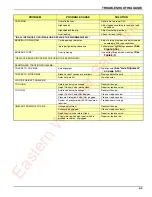
4-14
F-916-0217 Edition
MAINTENANCE AND LUBRICATION
Axle Alignment
Proper axle to king pin alignment is necessary to obtain
straight tracking. If axle alignment is off, “dog-tracking”
occurs. Check alignment manually or by using a
semitrailer alignment machine. In either case, a thorough
inspection of the complete suspension must be
performed and all defects corrected before aligning.
Manual Alignment Procedure
1. Position semitrailer on a firm and level surface.
Insure that the undercarriage is in the rear most
position. Eliminate any suspension binding due to
sharp turns or unusual maneuvers.
2. Detach tractor from the semitrailer and jack the trailer
up sufficiently to permit measuring from the
underside of the trailer.
3. Suspend a plumb bob at axle height from the center
of the king pin.
4. Measure (D) from the plumb bob to the center point
on one end of the axle. Record this measurement
5. Measure (D1) to the other end of the axle in the
same manner as in
Record this
measurement
6. Set D about 1/8” shorter than D1 to insure proper
trailer tracking on slope of road.
7. The suspensions must be in good repair with no
binding or other restrictions before aligning. All
defective parts of the suspension or axles must be
replaced immediately.
Air Ride Suspension Axles
The air ride suspension is aligned and adjusted at the
factory and it should not be necessary to align the axles.
If, however it does become necessary to align the axles,
the procedure is as follows:
1. To align air ride suspension axles, locate the front
axle equalizer beam pivot bolt in front hanger at front
end of lock nut. Loosen the suspension pivot bolt lock
nut. Rotate the head of the pivot bolt. For axle
alignment forward, rotate bolt head clockwise. For
axle alignment rearward, rotate the bolt head
counter-clockwise. Both sides of axle need to be
adjusted to prevent axle rise or fall.
2. Align the front axle using the method outlined in
“Manual Alignment Procedure” on page 4-14.
3. After proper alignment has been obtained, tighten
the suspension pivot bolt nut to the torque listed in
the table on
4. Align the rear axle to the front axle. Locate the rear
axle equalizer beam pivot bolt in hanger at front end
of driver’s side rear axle equalizer beam. Loosen the
suspension pivot bolt lock nut. Rotate the head of the
pivot bolt. For axle alignment forward, rotate bolt
head clockwise. For axle alignment rearward, rotate
the bolt head counter-clockwise. The rear axle
should be parallel with the front axle, with the
dimensions Y and Y1 being the same.
5. Align the rear axle to the center axle in the same
manner, as
with dimensions Z and Z1 being
the same. The rear axle should also be parallel with
the front axle, with dimensions Y plus Z equal to Y1
plus Z1.
6. Tighten the suspension pivot bolt nut to the torque
listed in the table on
Figure 4-8: Checking Axle Alignment
D
D1
Y
Y1
Z
Z1
CURBSIDE
STREETSIDE
Ea
st
ern
W
re
cke
r Sa
le
s
In
c
















































